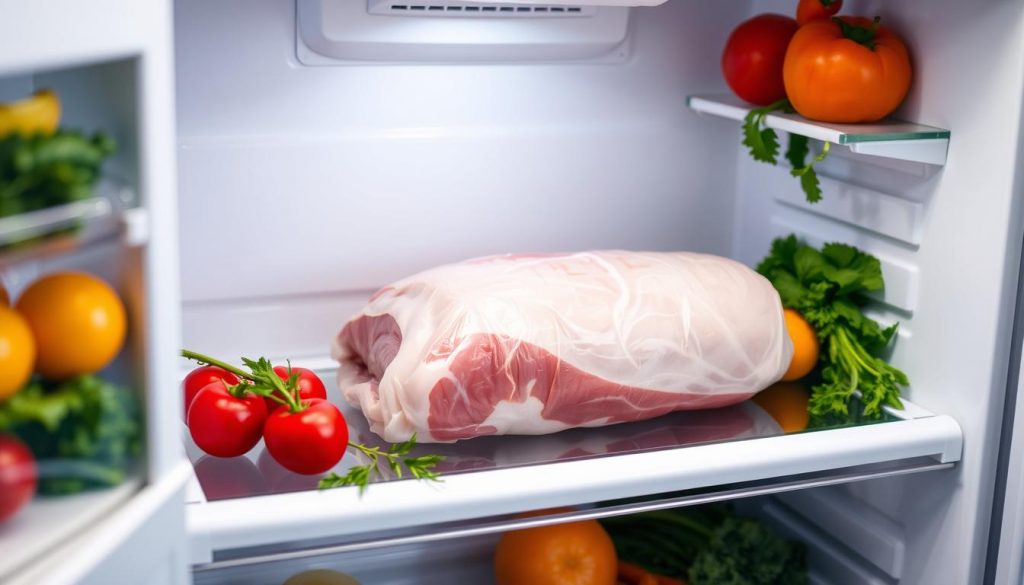Pork belly has become a popular meat cut in American kitchens. Keeping it fresh and safe is crucial. This guide covers pork belly storage and refrigeration essentials.
Proper storage maintains quality and ensures food safety. We’ll explore refrigeration methods, spoilage signs, and expert tips. These insights will help you maximize this delicious cut’s potential.
Our guide suits both experienced chefs and pork belly newcomers. You’ll learn to keep your meat fresh for future culinary adventures. Let’s explore the essentials of pork belly storage.
Key Takeaways
- Proper refrigeration is crucial for pork belly freshness
- Learn to spot signs of spoilage to ensure meat quality
- Understand optimal storage techniques for longer shelf life
- Discover USDA guidelines for safe pork belly handling
- Explore freezing methods for extended storage options
Understanding Pork Belly: From Market to Kitchen
Pork belly is a unique cut with special qualities. Let’s explore its features and how to choose the best piece for your kitchen.
What Makes Pork Belly Different
Pork belly is known for its rich fat content. This fat gives dishes a juicy, melt-in-your-mouth feel. It offers a perfect mix of meat and fat layers.
Pork belly’s versatility shines in various cooking methods. You can slow roast it or quickly fry it for delicious results.
Quality Indicators When Buying
When shopping for pork belly, meat quality is key. Look for even fat distribution and a pinkish-red color. The texture should be firm, with no strong odors.
These signs point to fresh pork that’s been handled well. Avoid pieces with discoloration or soft spots.
- Even fat distribution
- Pinkish-red color
- Firm texture
- No strong odors
Fresh vs. Cured Pork Belly
You’ll find two main types of pork belly: fresh and cured. Fresh pork belly is unprocessed and versatile for cooking. Cured pork belly, often used for bacon, has been treated with salt and sometimes smoke.
Each type offers distinct flavors and uses in the kitchen. Understanding these differences helps you choose the right pork belly for your recipes.
| Type | Flavor | Best Uses |
|---|---|---|
| Fresh Pork Belly | Mild, porky | Roasting, braising |
| Cured Pork Belly | Salty, smoky | Frying, sandwiches |
Pork belly offers endless culinary possibilities. You can enjoy the pure taste of fresh pork or the complex flavors of cured varieties.
How Long Does Pork Belly Last in the Fridge
Fresh pork belly lasts 3-5 days in the fridge. Cured pork belly can last up to 7 days when stored properly. These timeframes depend on various factors.
Here’s a helpful guide to track your pork belly’s freshness:
| Type of Pork Belly | Refrigerator Storage Time | Freezer Storage Time |
|---|---|---|
| Fresh, uncooked | 3-5 days | Up to 6 months |
| Cured, uncooked | 5-7 days | Up to 3 months |
| Cooked | 3-4 days | 2-3 months |
Keep your fridge at or below 40°F (4°C) to slow bacterial growth. This helps maintain meat quality and extends storage time. Always check for spoilage signs before eating.
Store pork belly in its original package or wrap it tightly. Use plastic wrap or aluminum foil. Place it on the bottom shelf to prevent juices from dripping onto other foods.
“Proper storage is key to maintaining the quality and safety of pork belly. When in doubt, always err on the side of caution.”
Follow these tips to keep your pork belly fresh and tasty. Your next culinary creation will be a hit!
Proper Storage Techniques for Maximum Freshness
Fresh pork belly is vital for safe and tasty meals. Learn top refrigeration tips to keep your meat fresh longer. These techniques will help you master meat preservation.
Best Storage Containers and Wrapping Methods
Use airtight containers or vacuum-sealed bags for pork belly storage. Tightly seal plastic wrap to block air exposure. Glass containers offer a clear view of the meat’s condition.
Optimal Temperature Settings
Keep your fridge between 32°F and 40°F for best pork belly preservation. This range slows bacterial growth without freezing the meat. Use a thermometer to maintain consistent temperatures.
Moisture Control Tips
Control moisture to prevent spoilage. Place a paper towel in the container to absorb excess moisture. For longer storage, use a dedicated meat drawer in your fridge.
This helps regulate humidity and keeps the pork belly fresh longer.
- Use airtight containers or vacuum-sealed bags
- Maintain fridge temperature between 32°F and 40°F
- Control moisture with paper towels or a dedicated meat drawer
- Check pork belly regularly for freshness
These food storage practices will extend your pork belly’s fridge life. Proper storage ensures quality and safety in your cooking adventures.
Signs of Spoilage in Pork Belly
Spotting spoiled meat is vital for food safety and pork quality. Learn how to identify bad pork belly to avoid health risks.
Visual Indicators of Spoiled Pork
Fresh pork belly should be pinkish-red with white fat. Discard the meat if you see these changes:
- Grayish-brown or greenish hues
- Mold growth (white, green, or black spots)
- Slimy or sticky surface
Smell and Texture Changes
Your nose can detect spoilage easily. Fresh pork has a mild, slightly sweet scent. Watch out for:
- Sour or ammonia-like odors
- Rancid smells
- Mushy or excessively soft texture
Safety Concerns and Health Risks
Eating spoiled pork can cause serious foodborne illnesses. Symptoms include nausea, vomiting, diarrhea, and fever. To stay safe:
- Always check the expiration date
- Store pork at the proper temperature
- Cook pork thoroughly to an internal temperature of 145°F (63°C)
If you’re unsure about the pork’s quality, it’s best to throw it away. Your health is more important than questionable meat.
Freezing Pork Belly for Extended Storage
Freezing pork belly keeps it fresh for months. This method extends its shelf life significantly. Let’s explore how to freeze pork belly effectively.
Cut your pork belly into cooking-sized portions. This makes thawing easier and reduces waste. Wrap each piece tightly in plastic wrap, removing air bubbles.
For extra protection, wrap again in foil or use freezer bags. Label each package with the date and weight. This helps track freezer time.
Use frozen pork belly within 4-6 months for best quality. It stays safe indefinitely at 0°F or below.
“Proper freezing techniques can significantly extend the shelf life of pork belly while maintaining its quality and flavor.”
Here’s a quick guide to freezing times for pork belly:
| Storage Method | Temperature | Maximum Storage Time |
|---|---|---|
| Refrigerator | 40°F (4°C) | 3-5 days |
| Freezer | 0°F (-18°C) | 4-6 months |
Freezing is just one part of pork preservation. Proper thawing and cooking are crucial for food safety. Follow these guidelines for delicious pork belly in your favorite recipes.
Thawing Methods and Best Practices
Safely defrosting meat is vital for food prep. Let’s look at effective ways to thaw pork belly. We’ll focus on keeping its quality and safety intact.
Refrigerator Thawing Guidelines
The safest way to thaw pork belly is in the fridge. Put the frozen meat on a plate to catch drips. Allow 24 hours of thawing for every 5 pounds.
This slow process keeps the pork at a safe temp throughout defrosting.

Cold Water Thawing Technique
For faster results, try the cold water method. Seal the pork in a leak-proof bag and submerge in cold tap water. Change the water every 30 minutes to maintain a safe temp.
This method takes about 30 minutes per pound of meat.
What to Avoid When Thawing
Never thaw pork belly at room temp or in hot water. These methods can lead to bacterial growth. Avoid using a microwave for large cuts like pork belly.
Microwaving can partially cook the meat, causing uneven texture.
- Don’t refreeze thawed pork without cooking it first
- Avoid thawing in the sink without water
- Never use warm or hot water for thawing
Follow these safe thawing practices for your pork belly. You’ll ensure it’s ready for tasty meal prep. Plus, you’ll cut down on food safety risks.
Tips for Preparing Stored Pork Belly
Get ready to transform your stored pork belly into a mouthwatering dish. These tips will help you create amazing pork belly recipes. Your taste buds are in for a treat!
Thawing is crucial for perfect pork belly. Move frozen meat to the fridge a day before cooking. This keeps it safe and juicy.
Once thawed, pat the pork belly dry with paper towels. This step ensures you’ll get that irresistible crispy skin.
Let’s explore some cooking techniques for pork belly:
- Roasting: Score the skin and rub with salt. Roast at high heat for crispy crackling.
- Braising: Slow-cook in liquid for tender, flavorful meat.
- Grilling: Slice thin and grill for a smoky flavor.
Try a dry rub or marinade for extra flavor. Mix brown sugar, salt, and spices for a tasty crust. Or soak in soy sauce, ginger, and garlic for an Asian-inspired dish.
“Pork belly is a versatile cut that shines with proper preparation and patience.”
Here’s a simple table comparing cooking methods:
| Method | Cooking Time | Best For |
|---|---|---|
| Roasting | 2-3 hours | Crispy skin lovers |
| Braising | 3-4 hours | Fall-apart tender meat |
| Grilling | 10-15 minutes | Quick, smoky flavor |
Pork belly is rich, so balance it with fresh sides. Try pickled vegetables or a crisp salad. These pairings will create a perfectly balanced meal.
Food Safety Guidelines and USDA Recommendations
Proper food safety is vital when handling pork belly. Let’s review key USDA guidelines to keep your meat safe. These practices ensure your pork stays delicious and healthy.
Temperature Control Standards
The USDA suggests cooking whole pork cuts to 145°F (63°C). For ground pork, aim for 160°F (71°C). Use a food thermometer to check the thickest part.
After cooking, let the pork rest for three minutes. This allows the juices to redistribute, enhancing flavor and texture.

Cross-Contamination Prevention
Keep raw pork separate from other foods. Use different cutting boards for raw meat and ready-to-eat items. Always wash hands, utensils, and surfaces after handling raw pork.
Safe Handling Practices
Follow these safety tips for meat handling:
- Refrigerate or freeze pork within two hours of purchase
- Thaw frozen pork in the refrigerator, never on the counter
- Use or freeze fresh pork within 3-5 days of purchase
- Store cooked pork in the refrigerator for up to 4 days
| Storage Method | Fresh Pork | Cooked Pork |
|---|---|---|
| Refrigerator (40°F or below) | 3-5 days | 3-4 days |
| Freezer (0°F or below) | 4-6 months | 2-3 months |
These food safety rules keep your pork belly safe. Follow them to enjoy delicious, healthy meals every time.
Common Storage Mistakes to Avoid
Food storage errors are common. Proper pork belly preservation is vital for kitchen safety. Let’s look at common mistakes and how to avoid them.
Improper packaging is a major storage blunder. Exposed or loosely wrapped pork belly attracts bacteria and loses freshness. Use airtight containers or vacuum-sealed bags to maintain quality.
Temperature changes harm pork preservation. Avoid storing meat in the fridge door. Place pork belly in the coldest part of your refrigerator, usually the back.
Cross-contamination poses a serious food safety risk. Never store raw pork belly above ready-to-eat foods. Use separate cutting boards and utensils for raw meat.
| Storage Mistake | Consequence | Prevention |
|---|---|---|
| Poor packaging | Bacterial growth | Use airtight containers |
| Temperature fluctuations | Faster spoilage | Store in coldest fridge area |
| Cross-contamination | Foodborne illness | Separate raw and cooked foods |
Avoid these storage mistakes to keep pork belly fresh and safe. Proper storage ensures you’ll enjoy this tasty cut at its best.
Conclusion
Proper refrigeration is crucial for keeping pork belly fresh. Raw pork belly stays good for 3-5 days in the fridge. Freezing is best for longer storage.
Wrap pork belly tightly and store at the right temperature. Watch for signs of spoilage to maintain flavor and texture. These steps help preserve the meat’s quality.
Thaw safely and avoid cross-contamination when handling pork belly. Cook it thoroughly to ensure it’s safe to eat. These guidelines help you enjoy this tasty cut.




